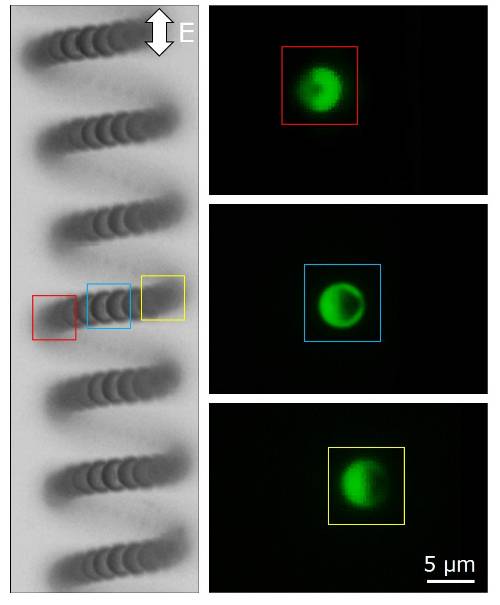Bharti Article on Microbots Published in Nature Communications
Titled ‘Colloidal Robots for Mimicking the Swimming Abilities of Bacteria’
June 12, 2019

Researchers from LSU developed a technique to mimic the helical motion of spermatozoa
in micron-sized particles (left). The helical motion in the electric field is achieved
by introducing a triangular metal patch on a spherical particle (right). Image credit:
Jin Gyun Lee and Bhuvnesh Bharti.
BATON ROUGE, LA – Assistant Professor of Chemical Engineering Bhuvnesh Bharti’s article, “Directed Propulsion of Spherical Particles Along Three-Dimensional Helical Trajectories,” was recently published in Nature Communications and seeks to answer the question of how to program the propulsion of artificial synthetic objects on a microscale.
The article was co-authored by LSU Chemical Engineering Professor William Shelton, LSU Chemical Engineering Graduate Student Jin Gyun Lee, Pennsylvania State University Chemical Engineering Graduate Student Allan Brooks, and Columbia University Associate Professor of Chemical Engineering Kyle Bishop. It will provide a new physical principle of designing next-generation microbots.
Their study is a step towards designing new autonomous microscale vehicles, which can perform complex functions necessary for advanced biomedical procedures, including non-invasive surgery.
The work was supported by the U.S. Department of Energy, with additional support from the Louisiana Board of Regents and the National Science Foundation.
The full article is available at https://www.nature.com/articles/s41467-019-10579-1.
“Inspiration for this work comes from the lack of ability to control motion of objects that are 1/100 the diameter of a human hair,” Bharti said. “The physics at this scale are very complex, and particles swimming in water at this microscale are equivalent to a human swimming in honey. Currently, we lack a facile tool to engineer surface forces on such particles that allow us to control the motion of micromachines at a microscale.”
“My Roomba vacuum cleaner has an on-board computer that instructs how it should move in response to environmental cues,” Bishop said. “For colloidal microrobots, we do not have the luxury of powerful computers and general purpose software. Instead, we have to encode these rather primitive ‘programs’ more directly into the particle itself.
“We add a metal patch to the spherical particle in order to instruct it how to move in the electric field. We use the shape of the metal patch as a primitive encoding medium—different patch shapes encode different motions in the field. This paper shows that the geometry of the metal patch can be a useful encoding medium for programming different types of complex motions in self-propelled colloids.”
One of the key aspects of the group’s research is the demonstration of the principle that a helically moving microsphere is more effective in navigating complex environments that contain several objects floating in their vicinity.
“A good analogy of this principle is…suppose you would like to cross a crowded street,” Bharti said. “If you try and run in a straight line, you may not get very far. However, if you are moving in a zigzag or curvilinear path, you may get much farther away and may even be able to cross the street.”
Nature Communications is an open-access journal that publishes high-quality research from all areas of the natural sciences. Papers published by the journal represent important advances of significance to specialists within each field.
Like us on Facebook (@lsuengineering) or follow us on Twitter and Instagram (@lsuengineering).
###
Contact: Joshua Duplechain
Director of Communications
225-578-5706 (o)